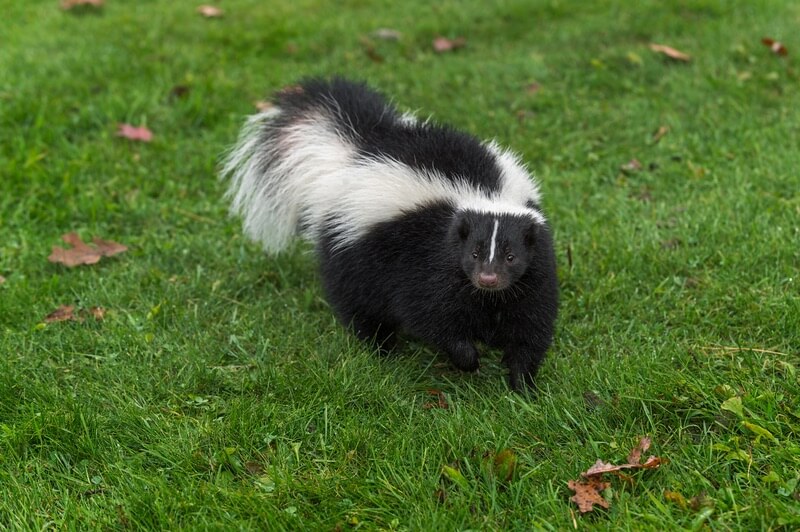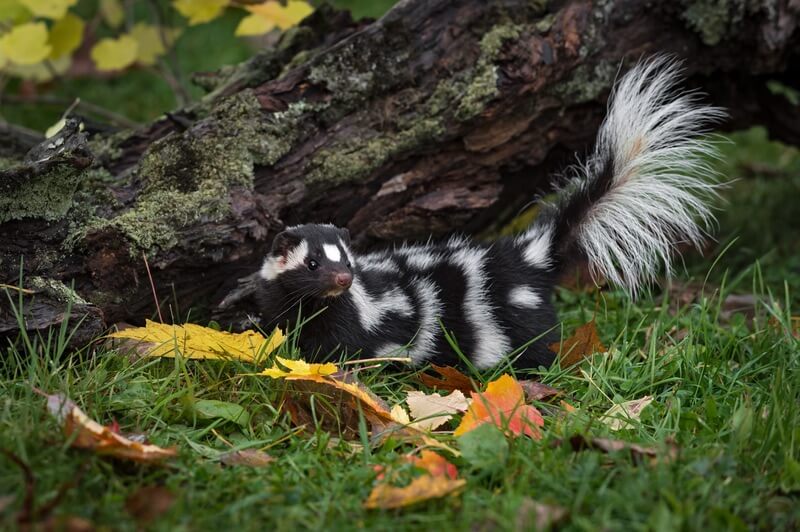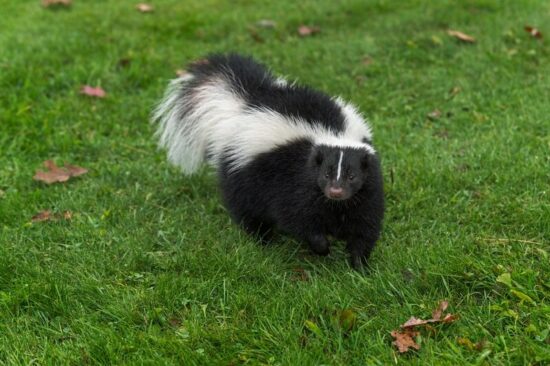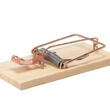Skunks are an iconic and frustrating pest that many people don’t know much about. They’re aware of their stench, but that’s about it!
Because of that, homeowners often wonder if skunks can climb or jump in order to get on their property. This guide will help you understand if that’s possible or not!
Table of Contents
Can Skunks Climb?
Skunks are some of the most feared pests you can come across in your backyard. It’s not that they’re particularly vicious, but these animals will spray you in self-defense.
And trust us, that’s not something you want to be on the other side of!
Skunk spray is notoriously tricky to get off. As a result, most people will flee when they see these black-and-white creatures.
On top of that, these animals have no problem digging up your lawn and getting into your garden. That’s why most homeowners would prefer that these creatures spend as little time on their property as possible.
You may take a look around your backyard and find yourself wondering if these pests are capable of scaling obstacles. In other words, can skunks climb well?
We have both good and bad news.
The good news is that, for the most part, skunks can’t climb very well. The bad news? There are a few species of skunk that can climb fences, trees, and more!
The general climbing ability of the skunk is pretty low. These animals prefer to stay low to the ground, scavenging for grubs and other food sources.
The pests aren’t built to be masterful climbers. While they have claws and somewhat agile hands, those biological markers are more suited to digging. Skunks would much rather burrow in the soil than take to the skies and scale vertical surfaces.
There are exceptions of course. If a skunk’s life is in danger, it may turn to a tree or higher surface to escape predators. However, that’s not very common.
Species Differences
As we hinted to above, some skunks can climb better than others. In the United States, there are roughly seven unique skunk species. But most pest control experts will view these seven species as two distinct varieties: Striped and spotted.
Most of us are familiar with the iconic striped skunk. It’s the one that’s all over TV and regularly seen in yards across the country. These skunks are slow and large. They’re the girthier of the two varieties.

Striped skunks have a few things working against them when climbing. They are heavier and have long nails that prevent them from having a good grip. The nails are great for digging but aren’t conducive to climbing.
A striped skunk may successfully climb taller surfaces with platforms and a super grippy surface. But the animal won’t get far unless the conditions are just right.
Things are a little different for the spotted skunk.
Spotted skunks are smaller and more agile than their striped counterparts. They also have claws that are better adapted for climbing. These creatures can get a firmer grip on vertical surfaces, allowing them to scale objects that striped skunks wouldn’t even attempt!

These skunks are squirrel-like in their behavior. But even still, they prefer to stay on the ground when possible. These skunks can climb trees and fences, but they usually refrain unless their safety is at risk or they’re trying to eat high-up foods like a beehive.
What Is The Highest They Can Climb?
If you’re worried about having to check above you for a spraying skunk, you can breathe easy. No skunk species can scale ultra-high surfaces like squirrels and other climbing rodents. There’s no need to concern yourself with pungent spray raining down the skies!
That said, some skunk varieties can climb higher than most people realize.
The spotted skunk is the most capable. It can climb up to six feet on average. But of course, many factors will affect their total climbing distance.
The biggest is the surface itself. While these animals have agile hands, claws for gripping, and padded feet for stability, they can’t climb up smooth walls.
That means smooth stucco-covered exterior walls, vinyl fences, and brick barriers are out of the question. Skunks can’t climb those smooth surfaces because they can’t get traction. Their weight is too much to hurl over the fence without adequate grip.
Another thing to consider is the climbing route. If the skunk has a place to rest and get its bearings, it could climb higher. This is how spotted skunks get in chimneys and attics.
They climb a short distance to the roof before resting. Then, they continue up the chimney before resting again. Six feet is the average climbing height, but the environment could allow the creature to get even higher.
Once again, striped skunks are a different story. These stocky pests are less keen on climbing over elevated surfaces. While they can push themselves more if they need to evade predators, most striped skunks have no interest in climbing more than 18 inches at the most.
That’s enough to scale rocks and logs but not enough to overcome most barriers.
Can Skunks Climb Trees?
Striped skunks seldomly climb trees. A striped skunk can get onto trees only if they have assistance from mesh or raised platforms. Once again, their biological design isn’t suited for tree-dwelling!
The animal’s stocky body would weigh them down too much. Plus, their long claws become a hindrance when trying to get up a tree.
Skunks don’t technically hibernate, but they find safe living spaces to survive cold spells. You don’t have to worry about finding a striped skunk in a tree hollow.
However, they can live near your home. Many striped skunks will burrow underneath decks and patios, leaving a nasty surprise if you encounter them.
Spotted skunks can climb trees. They are relatively skilled climbers and often use trees to get closer to other surfaces.
Many of these skunks will also climb up trees to access food. They love fruit and honey from beehives. In the winter, spotted skunks may use tree hollows to stay warm.
They don’t build traditional nests but can use existing spots abandoned by other animals.
You’re most likely to see these spotted pests scurrying up trees if there’s a predator nearby. It’s a last-ditch effort to escape capture. The animal will utilize its sprayer first, but their climbing ability is that fall-back talent they use immediately after to get out of harm’s way.
Despite their inherent climbing abilities, it’s important to remember that even spotted skunks aren’t natural tree-climbers. Their climbing is slower and more deliberate. It’s also a rarer sight, so don’t expect to see spotted skunks living in trees too often.
Can Skunks Climb Fences?
If a spotted skunk can climb up to six feet, does that mean it can scale a fence? Unfortunately, it does.
Homeowners dealing with skunk issues often find themselves scratching their heads regarding how these animals got in. Most don’t even consider fence scaling, but it’s a real possibility.
How well a skunk can get up a fence depends entirely on the material.
As we discussed earlier, smooth fences are a real obstacle for skunks. Even the more capable spotted variety can’t climb a fence if it doesn’t have places to grip.
Vinyl fences are an excellent skunk-climbing deterrent. They are smooth to the touch and don’t easily puncture the animal’s claws. Smooth stucco and hard brick offer similar protection.
Wood can be hit-or-miss. Traditional picket-style fences are more challenging for the animal, but they may manage if the wood is soft enough for their claws.
The worst fences to have when dealing with spotted skunks is anything that has mesh. Chain link is nothing for a spotted skunk. They will stick their hands through the links, grab onto the metal, and make their way up in minutes!
You might witness something similar if you have a fence with horizontal slats. For example, lattice fences are just as bad as chain links.
On the plus side, you don’t have to worry about striped skunks climbing fences. As long as your fence is more than 18 inches tall, it’ll prevent them from climbing over.
However, you may have to worry about burrowing. Striped skunks are keen on digging underneath fences. They can tunnel up to two feet below the surface, so you’ll need to ensure that your wall extends deep below the soil for safety.
Can Skunks Jump?
Believe it or not, skunks are decent jumpers. A healthy adult can usually leap up to three feet. Their powerful hind legs provide plenty of power and momentum.
Fortunately, that’s not enough to get over most property boundaries. Skunks cannot jump over your fence in one swift move. They may use jumping moves to clear low garden borders and other simple borders.
However, their jumping capabilities are nowhere good enough for the animal to leap into your yard without having to do a little bit of climbing.
Even then, most skunks aren’t going to risk falling. A spotted skunk might make it over your fence and leap onto another surface. But they may abandon the plan and turn around if there’s no clean way to get down.
Unlike squirrels that walk along your fence line and leap to the ground, skunks typically don’t do that. Jumping from high up would only put the animal at risk for injuries.
Conclusion
Depending on the kind of skunk you’re dealing with, climbing fences and trees might happen from time to time. However, rest assured that these animals don’t want to climb if they don’t have to.
While that doesn’t mean a tall fence will keep all skunks away (they’re quite effective diggers), it’s one less thing for you to worry about!


